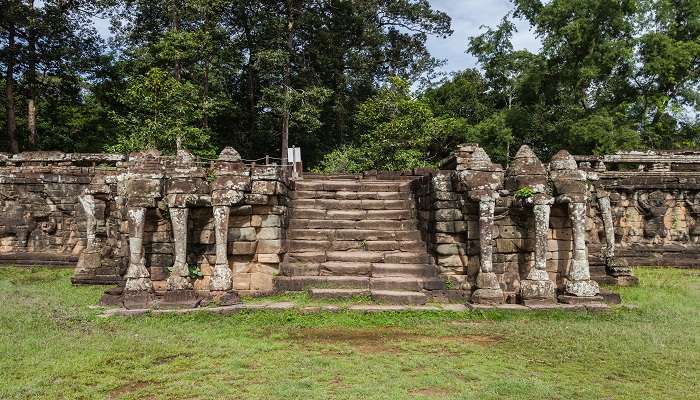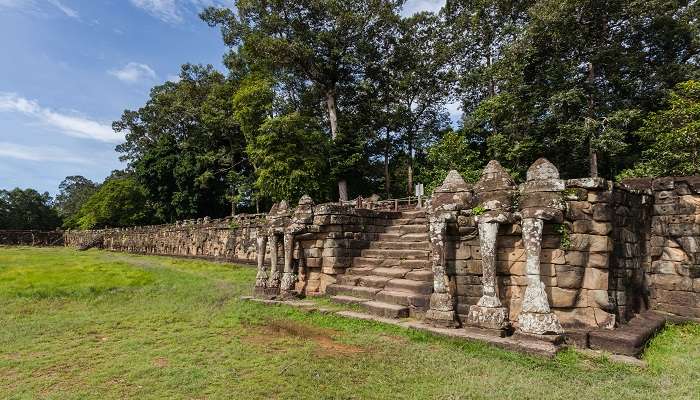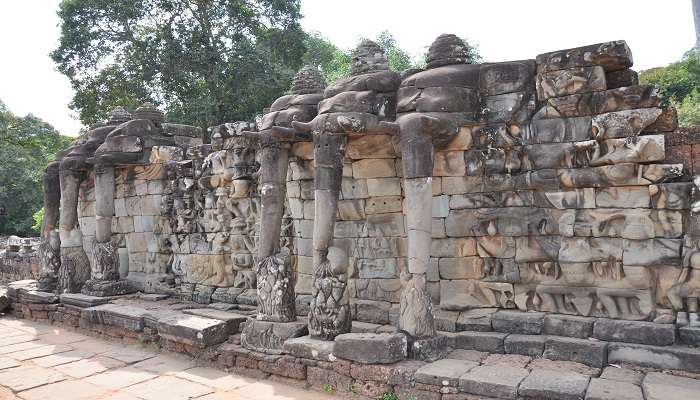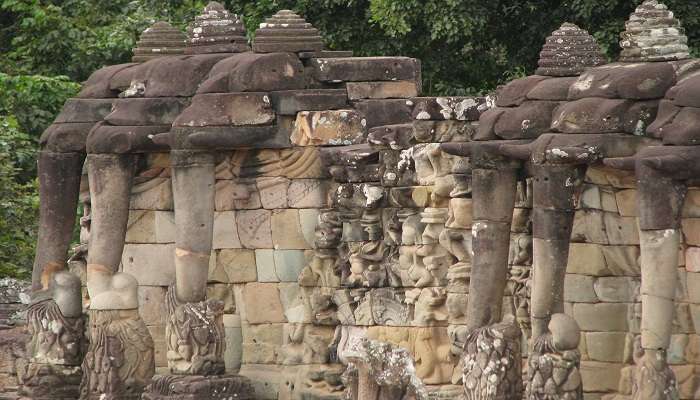Visit The Terrace Of The Elephants To Explore Cambodia’s Majestic Historical Site

Nestled within the ancient Khmer ruins of Angkor Thom, the imposing Terrace of the Elephants stands as a symbol of the brilliance of the Khmer Empire. This remarkable structure was once a revered platform reserved for the king and his mighty elephants to view grand ceremonies and processions. As you approach the terrace, you can’t help but be awestruck by its sheer size and the level of artistry that went into its construction. The laterite walls stretch for over 300 meters, adorned with detailed bas-reliefs depicting life-sized elephants, each brilliantly carved with remarkable detail and precision. Stepping onto the terrace, you can imagine the pomp and circumstance of bygone eras, when the Khmer kings would hold court and witness elaborate rituals unfold before their eyes. Whether you’re a history buff, an architecture enthusiast, or simply someone who appreciates the marvels of human ingenuity, the Terrace of the Elephants is sure to leave you in awe.
About Terrace Of The Elephants

The Terrace of the Elephants is a grand structure in the walled city of Angkor Thom in Cambodia. It is part of the sprawling Angkor temple complex. Imagine it as a giant viewing platform, some 350 metres long, adorned with intricate carvings, especially elephants (hence the name).
The most striking feature is the series of bas-relief carvings that adorn the retaining wall. These carvings depict a procession of elephants with their riders and other figures from Hindu and Buddhist mythology, like garudas (bird-like humanoids) and warriors. The northern part of the terrace is particularly noteworthy for its detailed sculptures, including a five-headed horse, dancers, and more.
Must Read: Royal Palace In Phnom Penh
History Of Terrace Of The Elephants

Built-in the late 12th century by King Jayavarman VII, the Terrace of the Elephants it served important roles beyond its decorative beauty. Initially designed as a viewing platform, it gave the king a strategic vantage point to observe his returning army. Picture the scene: victorious soldiers, infantry, cavalry, and elephants parading across Central Square with flags held high.
The terrace wasn’t solely for military purposes. It also functioned as a massive viewing stand for public ceremonies, where the king could oversee gatherings and important rituals from above. Additionally, it supported the grand audience hall, anchoring its significance within the royal complex. Interestingly, the Terrace of the Elephants was not an independent structure. It was once connected to the royal palace of Phimeanakas, forming part of the expansive Elephant Terrace complex at the heart of the Khmer capital. While much of the original palace has faded with time, the terrace’s sturdy construction has preserved it relatively well.
Architecture

The Angkor Wat Elephant Terrace has an impressive architecture. The elongated platform stretches roughly 350 metres along a north-south axis, which defines the basic layout of the Terrace of the Elephants. Constructed from sandstone, the terrace stands at a height of around 4 metres and has a width of 15 metres for most of its length.
The eastern facade incorporates five projecting sections called outworks. These outworks serve as access points to the terrace, functioning like giant staircases. The central outwork is the most elaborate, designed in a cruciform shape with a grand staircase and platform leading to the presumed entrance of the Royal Palace, which is no longer in existence. The other four outworks are smaller but still provide staircases for ascending the terrace. The terrace lives up to its name. The most striking feature is the magnificent elephant carvings adorning the eastern face. These are not mere silhouettes but life-sized sculptures rendered in high relief. The central section of the retaining wall showcases additional impressive carvings—regal lions and mythical garudas (bird-human creatures). The northern and southern ends come alive with depictions of a grand elephant procession, complete with elaborately adorned mahouts (elephant riders)—a testament to the Khmer’s artistic mastery.
Suggested Read: Places To Visit In Phnom Penh
Timings, Fees, and Best Time To Visit

The Terrace of the Elephants is generally open daily from 7:30 AM to 5:30 PM. Entrance to the Terrace of the Elephants is included in the Angkor Wat ticket, which grants access to the entire Angkor Archaeological Park. Ticket prices vary depending on the validity period:
- One-day pass: $37
- Three-day pass: $62
- Seven-day pass: $72
Tickets can be purchased at the Angkor Wat ticketing office or online in advance.
The best time to visit the Terrace of the Elephants depends on what you prioritise:
- For Cooler Temperatures: The dry season (November to March) is generally considered the best time to visit Angkor Wat Elephant Terrace, with average temperatures ranging from 20°C (68°F) to 30°C (86°F). However, this is also the peak tourist season, so expect larger crowds.
- For Fewer Crowds: If you prefer a quieter experience, consider visiting during the shoulder seasons (April to May and September to October). While the weather may be hotter and humid, you’ll likely encounter smaller crowds.
How To Reach The Terrace Of The Elephants?

Reaching the Terrace of the Elephants involves several ways, including:
By Air: Siem Reap International Airport (REP) is the nearest airport. Many international flights arrive at this airport, so it is likely the most convenient way to get to the city. You can take a taxi, tuk-tuk, or ride-sharing service from the airport to Angkor Wat Elephant Terrace. The journey takes about 20-30 minutes.
By Road: You can’t directly access the Terrace of the Elephants by road itself since it’s situated within the Angkor Thom complex. But here’s how to get there using local transportation options once you’re in Siem Reap:
By Tuk-Tuk: This is a popular and affordable way to get around Siem Reap, especially for tourists. You can easily hail a tuk-tuk on the streets or arrange pick-up from your hotel. Negotiate the fare before setting off—a typical ride from Siem Reap town centre to Angkor Wat Elephant Terrace should cost around $15-20 USD for a single journey.
By Taxi: Taxis are another option, offering a bit more comfort than tuk-tuks but typically costing more. You can find taxis at nearby taxi stands or hail one on the street. Expect a fare of around USD 30 for a trip to Angkor Wat from Siem Reap town centre.
By Bicycle: For the truly adventurous and budget-conscious traveller, renting a bicycle is a great way to explore the Angkor Wat complex, including the Terrace of the Elephants. It’s a 6-kilometre ride (around 4 miles) from Siem Reap town centre to Angkor Wat. Bicycle rentals are widely available in Siem Reap, starting at around $2 daily.
Local Bus: Public buses are the most economical choice. While they won’t take you directly to the Terrace, they can drop you off near the Angkor Wat entrance. You’ll then need to walk (around 30 minutes) or take a tuk-tuk for the last leg.
Further Read: Bokor Hill Station
Terrace of the Elephants is an awe-inspiring architectural marvel that stands as a testament to the ingenuity and craftsmanship of the Khmer Empire. Its elaborate carvings and impressive scale transport visitors back in time, offering a glimpse into the grandeur of an ancient civilisation. If you find yourself captivated by the allure of this magnificent structure and the rich cultural heritage of Cambodia, consider booking a trip to Cambodia to explore this enchanting land firsthand. Discover the warmth of Cambodian hospitality and create unforgettable memories that will forever etch themselves into your soul. Don’t miss the opportunity to witness history come alive before your eyes.
For our editorial codes of conduct and copyright disclaimer, please click here.
Cover Image Credit: Diego Delso for Wikimedia Commons
Frequently Asked Questions About Terrace Of The Elephants
What is the elephant temple in Angkor Wat?
The Elephant Terrace is a significant part of Cambodia's Angkor Thom temple complex. The terrace gets its name from the elephant carvings on its eastern face. The Angkor Wat temple complex is vast, spanning about 400 acres and includes over 1000 structures, water systems, and pathways.
What is the history of elephants in Cambodia?
Asian elephants have been a significant part of Khmer culture in Cambodia for thousands of years. The magnificent temples of Angkor in Siem Reap province of northern Cambodia prominently feature elephants. Over 6,000 elephants were estimated to be employed in constructing the Angkor Wat complex. Before and during the Angkor period, elephants were used in battles, temple construction, and major ceremonies.
Why do Cambodia have Hindu temples?
The construction of Hindu temples in Cambodia began during the Funan kingdom, which flourished from the 1st to the 6th century CE. The Indian culture and religion, brought by traders and political alliances, blended with local customs, influencing the architecture and religious beliefs. This fusion laid the foundation for the Angkor period, which was renowned for its grand Hindu temples.
What was the purpose of the Terrace of the Elephants?
The terrace served several purposes. Primarily, it was a giant viewing platform for public ceremonies, allowing the king and important officials to observe parades, victorious returning armies, and other events happening in the square below. It also functioned as a base for the king's grand audience hall, where he would meet with important visitors and officials.
What else can you see besides elephants?
While the elephants are the most prominent feature, the Terrace of the Elephants has other exciting carvings. The northern part of the wall features sculptures, including a five-headed horse, garuda (bird-like humanoids from Hindu and Buddhist mythology), dancers, and warriors.
People Also Read:
Places To Visit In Cambodia Things To Do In Cambodia Cambodia Resorts

With a passion for exploring and travelling to the roads long forgotten, experience the world through enthralling stories and adventures. Join me as I share my experiences at some of the world’s most popular tourist destinations and quench that pestering curiosity with something exciting!











